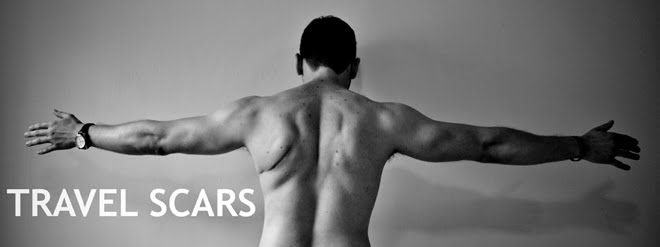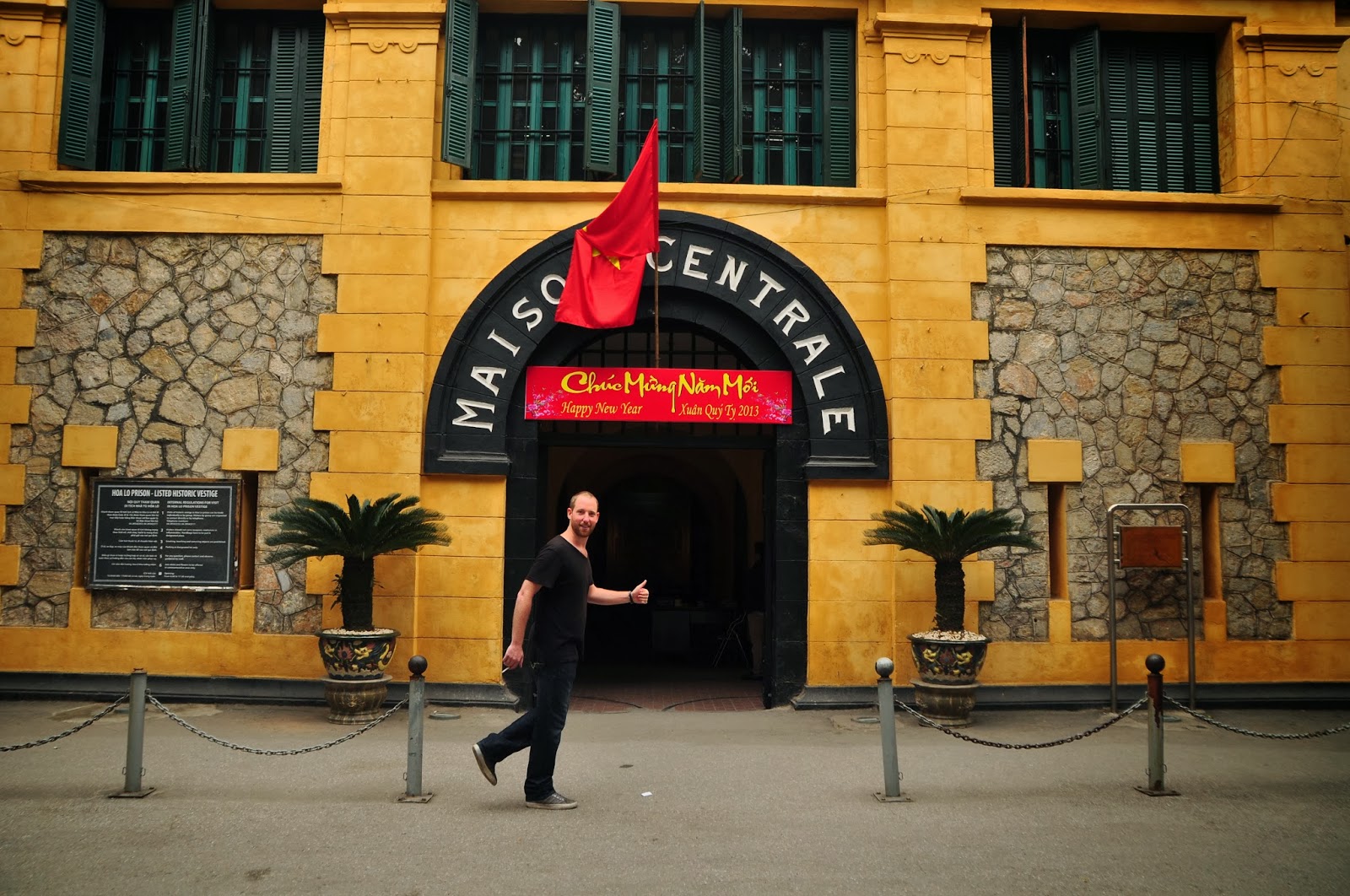Feb 25th-27th
MICHAEL ALAN RISI has been a friend of mine for quite some time: we met while traveling in Amsterdam in 2006, and have since traveled together to eastern Canada, Spain, Portugal, Andorra and Morocco; and most recently to Las Vegas along with Josh in 2011. Mike is one of the few people I know who is always down to meet up somewhere in the world and never breaks his travel promises.
Josh and I had coordinated our time in Laos to coincide with Mike's arrival in Hanoi.
Once off the murder bus, we split a cab with some eastern European guy and were let off in Hanoi's famed Old Quarter, where Mike had reserved us a room at the incredible Hanoi Backpackers (www.hanoibackpackershostel.com).
When we entered the hostel we were greeted by a vast majority of our fellow passengers from the murder bus.
Great. The party had come to us!
When we got to our room, we found Mike passed out on the bed due to a combination of jet-lag and anticipatory partying prior to our arrival.
We woke him up but the importance of this reunion was slow to dawn on him considering his semi-lucid state. Once he came to, he had the celebratory reaction Josh and I had been expecting.
We exchanged crazy stories detailing how we had got to Hanoi and proceeded to join the others for a late-night snack.
Hanoi, much like Laos, has a strict communist-imposed curfew at midnight and finding anything to eat or drink proved rather difficult.
We finally found a roadside pastry-shop and then a Spanish bar whose drawn shades and toned-down music reminded me of a speakeasy during the prohibition-era United States.
We finished our contraband and called it a night.
Hanoi, Vietnam's capital city, is the country's vibrant epicenter of culture, history and culinary splendor. Having survived over 1000 years of rule by the Chinese; colonization by the French; occupation by the Japanese and bombardment by the Americans, it still stands as a testament to the strength of the northern Vietnamese people and has been the capital of a reunified Vietnam since the end of the Vietnamese War in 1976.
With so much to see and do, we divided up our explorations into various districts. Our first stop was Hoa Lo Prison, just a short walking distance from the Old Quarter.
Hoa Lo Prison was originally built by the French Colonists in 1886-1889, and used to detain Vietnamese political prisoners opposed to the French's colonization of Indochine, Hanoi being its capital.
During the Vietnamese war, it was used by the North Vietnamese to incarcerate American POWs. Many American pilots were held there including the eventual Republican Presidential nominee John McCain. It is during this time that the prison was mockingly nicknamed "The Hanoi Hilton".
The prison now acts as a museum and contains various exhibitions depicting the 'conditions' prisoners lived in. Like any communist regime, propaganda is their weapon of choice, and these depictions are said to be far less barbaric than they actually were: they have pictures of American soldiers playing sports, and have no mention of the torture and poor conditions that the POWs were actually subjected to.
Our next stop was to Hanoi's famous Temple of Literature. This Confucius temple was built in 1070 A.D. and is considered Vietnam's first University.
The temple itself is modeled after that of its namesake in Qufu, China, and comprises five courtyards.
It was a beautiful place and would have been quite peaceful if it weren't for the hundreds of tourists meandering inside. What was rather nice, however, was that there was a procession of women dressed in traditional costumes performing a ceremony as we approached the main courtyard.
From there we made a brief stop at the Lenin Monument and then headed to Hoan Kiem Lake.
Hoan Kiem lake is at the center of historic Hanoi and serves as a refuge from the chaos unfolding around it. At its center is Ngoc Son Temple which is dedicated to a 13th century military leader who fought the Chinese occupation.
Not only is it a place of spiritual significance, but also a place where tourists flock, elderly locals play games and children search for the rarely-seen turtles apparently living in the lake.
The following day Mike and I made decided to explore some of Hanoi's lesser visited spots. We started by passing the Hanoi Opera house and made our way back to the Old Quarter.
On the way we stopped at the memorial house: one of the Old Quarter's best restored properties. It is a traditional merchant's house and a good representation of what a wealthy Vietnamese family would have lived in a hundred years ago.
We continued to explore the Old Quarter with its city gates and frenetic atmosphere. After dodging hundreds of thousands of motorbikes at every turn, we finally reached Dong Xuan Market, the largest covered market in Hanoi. To be honest, this market; while big and selling pretty much everything, proved to be worth only a few minutes of browsing before we lost interest and decided to head back to the hostel.
Our final stop before meeting up with Josh was the Ly Thai Tho statue and his accompanying park. Ly Thai Tho was the emperor who moved Vietnam's capital city to Hanoi and who ruled the country from 1009-1028A.D. Considering his importance to the city, I would have figured his statue would have been bigger.
It seems that no matter how important somebody is to Vietnam or the country's ancient history, no one even comes close to the significance and importance of this contemporary figure in Vietnam: Ho Chi Minh.
Ho Chi Minh, meaning bringer of light, was the founder of the Vietnamese Communist party and the first president of the Democratic Republic of Vietnam from 1946 to his death in 1969. Not only did he lead a guerrilla campaign and defeated the french in 1954, but he also went on to lead Northern Vietnam against the South Vietnamese and the Americans in the Vietnamese war. He died before the end of the war and never got to see the reunification of the two Vietnams in 1975 following the South's surrender to the North.
He is a venerated figure throughout the north of Vietnam (many southerners don't share the same admiration, which is rather understandable), and affectionately known as "Uncle Ho" to many Vietnamese, young and old.
Although he is referred to as uncle, he is treated more like a god in this city of 3.7 million. He is on all their money, the hilarious named Dong; has countless statues, museums and monuments dedicated to him; and even had the capital of Southern Vietnam renamed to Ho Chi Minh City from its former name of Saigon, following their defeat to the North.
Despite his modest lifestyle, and desire for a simple cremation, the grandest monument of all is his mausoleum located in the center of the city. Like Lenin and Stalin before him, it was decided that he would be embalmed and put on display for a Vietnamese to pay their respects.
The mausoleum itself is an imposing structure and heavily guarded by white-clad soldiers. It is said that it was constructed by materials coming from all across the reunified country. Before entering, I had to check in my camera and hope that it would be returned to me upon my exit.
Mike and I had to leave relatively early in the morning in order to make it during the 2-hour window it is open each day. Once we finally entered the heavily air-conditioned building, I was in awe of the surprisingly well-preserved corpse of uncle Ho and the 4 soldiers guarding his body in statue-like positions. We had to walk in single-file and weren't allowed to stop and stare: we were out of the building within a few minutes of entering it and my camera was thankfully returned to me as promised.
We then walked to the One Pillar Pagoda, which is also within the mausoleum complex and was constructed by Ly Thai Tong in 1049 . The pagoda itself is a reconstruction as the original was destroyed by the french before they were expelled from the country. Putain!
We then visited the Ho Chi Minh Museum and got a big enough dose of Ho to last us at least a few weeks. Thinking that Josh would eventually meet us outside the mausoleum, we sat around and waited. He never came but we did get to talk to a Vietnamese student. While she must not have been older than her early twenties, she spoke of uncle Ho as if he was her father.
From there we went to the Army museum and took numerous photo ops with all the weaponry on display outside the museum.
It is also located next to the iconic flag tower, which provides nice views over the museums grounds.
Our final stop of the day was the Hanoi Citadel. Despite my obsession with UNESCO World Heritage sites and most touristic places of interest, I only found out what this building was after looking it up upon my return to Canada.
The citadel was originally built built it 1010A.D., and remained the seat of Imperial Vietnam until 1810, when the capital of Vietnam was changed to Hue.
Despite its UNESCO designation in 2010, Mike and I were the only westerners there and could enjoy a leisurely stroll around its grounds. It didn't hurt that a large group of beautiful Vietnamese women were taking photos in traditional costumes while I took photos of them with my zoom lens like a creeper.
From what I've written, it may sounds as though all we did was visit historical sites, visit museums and pay respect to a certain Ho. However, Hanoi has way more to offer than just that.
In fact, Hanoi has one of the better backpacker scenes in South East Asia. First of all, the hostel, Hanoi Backpackers, is one of the best hostels I have ever been to. They had nightly barbeques, giant jenga games and would have a free keg of Bia Hoi every couple of days.
To the uninitiated, Bia Hoi means fresh beer and literally has to be drunk within a day or two of when it is produced, otherwise it goes bad. You can find it all over Vietnam and it usually sells for around 10 cents a mug or less (not even kidding).
The hostel had a second property that we usually ended up at after our free keg and where the party continued. It was closer to some other bars and clubs, including the infamous Hair of the Dog bar, that we would wind up at after closing down the hostel bar.
So with an amazing party scene; great food and terrific coffee; and more history than you can shake a stick at; Hanoi can still provide you with enough Ho without wasting all your Dong!
Monday, April 21, 2014
Subscribe to:
Comments (Atom)
























